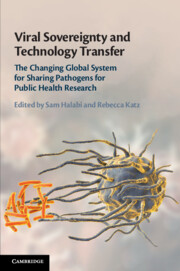 Viral Sovereignty and Technology Transfer
Viral Sovereignty and Technology Transfer Book contents
- Viral Sovereignty and Technology Transfer
- Viral Sovereignty and Technology Transfer
- Copyright page
- Contents
- Maps
- Tables
- Contributors
- Preface
- Acknowledgments
- Introduction Viral Sovereignty, Technology Transfer, and the Changing Global System for Sharing Pathogens for Public Health Research
- Part I The Geopolitical, Historical, and Scientific Context
- 1 The History of Accessing and Sharing Human Pathogens for Public Health Research
- 2 Attitudes towards Transfers of Human Research Samples across Borders
- 3 The Scope of Global Infectious Disease Research
- Part II Health Security, Research Ethics, and Human Rights Implications
- Part III Solutions: Standard Material Transfer Agreements, Repositories, and Specialized International Instruments
- Index
3 - The Scope of Global Infectious Disease Research
Field Capture, Quarantine, and Sample Transfer to Detect Emerging Pathogen Threats
from Part I - The Geopolitical, Historical, and Scientific Context
Published online by Cambridge University Press: 15 May 2020
- Viral Sovereignty and Technology Transfer
- Viral Sovereignty and Technology Transfer
- Copyright page
- Contents
- Maps
- Tables
- Contributors
- Preface
- Acknowledgments
- Introduction Viral Sovereignty, Technology Transfer, and the Changing Global System for Sharing Pathogens for Public Health Research
- Part I The Geopolitical, Historical, and Scientific Context
- 1 The History of Accessing and Sharing Human Pathogens for Public Health Research
- 2 Attitudes towards Transfers of Human Research Samples across Borders
- 3 The Scope of Global Infectious Disease Research
- Part II Health Security, Research Ethics, and Human Rights Implications
- Part III Solutions: Standard Material Transfer Agreements, Repositories, and Specialized International Instruments
- Index
Summary
Chapter 3 explains the process by which researchers identify pathogens ultimately used for public health research. It describes the field capture of animals, clinical sampling of animals and people, analysis for genetic sequencing data, transfer of samples to reference laboratories outside of low- or middle-income countries, and how confirmed infections are reported to public authorities for both public health and sovereign resource reasons. The chapter argues that the process by which researchers now obtain data requires far more bureaucratic barriers, but that correspondingly, researchers are more likely to partner with local scientists and institutions, thus building capacity for disease surveillance and response should an infectious disease threat emerge.
Keywords
- Type
- Chapter
- Information
- Viral Sovereignty and Technology TransferThe Changing Global System for Sharing Pathogens for Public Health Research, pp. 56 - 72Publisher: Cambridge University PressPrint publication year: 2020


